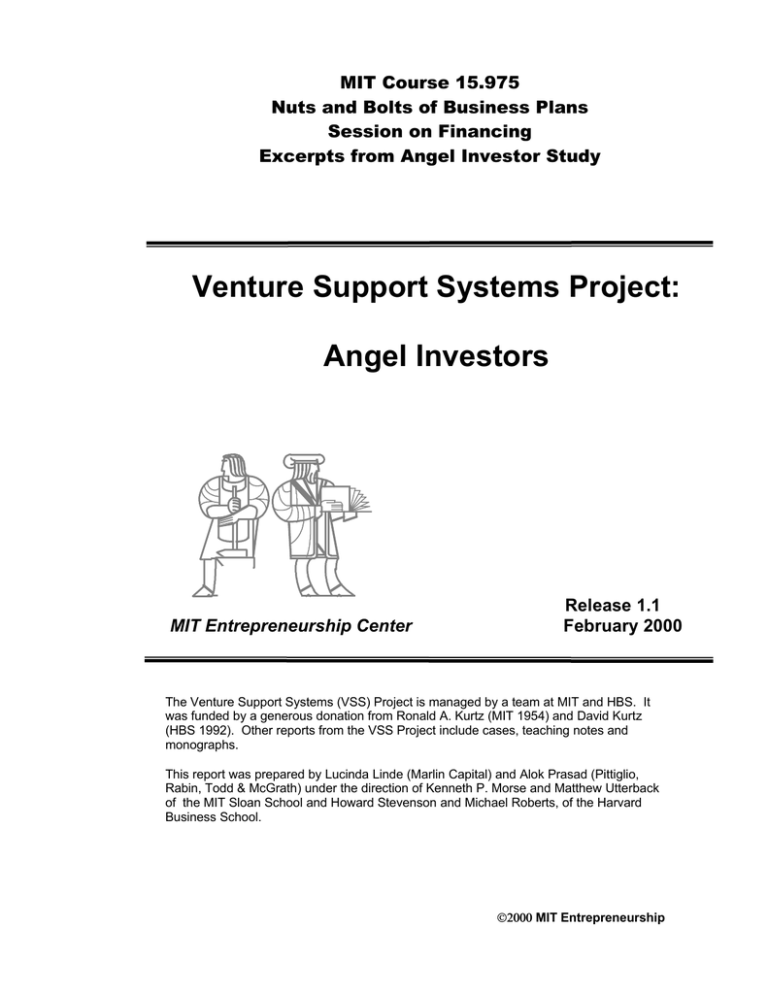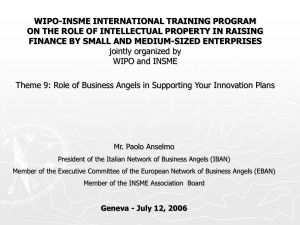MIT Course 15.975 Nuts and Bolts of Business Plans Session on Financing
advertisement

MIT Course 15.975 Nuts and Bolts of Business Plans Session on Financing Excerpts from Angel Investor Study Venture Support Systems Project: Angel Investors MIT Entrepreneurship Center Release 1.1 February 2000 The Venture Support Systems (VSS) Project is managed by a team at MIT and HBS. It was funded by a generous donation from Ronald A. Kurtz (MIT 1954) and David Kurtz (HBS 1992). Other reports from the VSS Project include cases, teaching notes and monographs. This report was prepared by Lucinda Linde (Marlin Capital) and Alok Prasad (Pittiglio, Rabin, Todd & McGrath) under the direction of Kenneth P. Morse and Matthew Utterback of the MIT Sloan School and Howard Stevenson and Michael Roberts, of the Harvard Business School. �2000 MIT Entrepreneurship Center Executive Summary Angel investors are an important and growing source of financing for the start-up and initial growth phases of technology ventures. This study focused on high net worth angel investors with entrepreneurial backgrounds. Many of these angels invest in first time entrepreneurs before the entrepreneurs secure venture capital financing. Besides earning a strong return on their investment, these experienced angels are motivated to “give back” to the community which helped make them successful. Very little published data is available on angel investing and little research has been done on the experienced angel investor. It may be valuable for first time entrepreneurs, venture capitalists, regulators and other members of the venture community to understand, leverage and support this growing class of experienced angel investors. This study introduces and defines the experienced angel investor, outlines the angel investing process, discusses the rise of organized angel groups, and provides advice for high net worth individuals aspiring to become angel investors. The intended audiences are business school students, aspiring entrepreneurs, aspiring angel investors, and other members of the venture support system. Some of the key findings of this study are: • Angels vs. Early Stage Venture Capitalists: The motivations and operations of experienced angel investors are typically different than those of early stage venture capitalists. First time entrepreneurs can benefit from approaching experienced angel investors, prior to meeting early stage venture capitalists, when seeking early stage funding. This study outlines the differences. • The “Network of Trust”: An angel’s personal network of contacts is a key element in screening deals, conducting due diligence, negotiating terms, adding value after the investment, securing additional rounds of funding and executing the exit strategy. • “Not All Angels are Alike”: It pays for entrepreneurs to understand the type of angels they need and the role that the angels will play in building their company. We have categorized angels into four groups: Guardian Angels, Operational Angels, Entrepreneur Angels and Financial Angels. We describe how these various angel types operate and how they provide different value to emerging ventures. • Systemization is on the Rise: Experienced angel investors are becoming increasingly systematic in their operation. Systematic evaluation and analysis help reduce risk, improve returns, and increase the number of deals considered. • The Need to Clarify the Angel Investing Process and Terms & Conditions: We found wide variation in the way angel investors conducted the investing Page 2 �2000 MIT Entrepreneurship Center process, in particular, regarding the specific terms and conditions (T&C’s) of the term sheet. We devote a chapter to understanding the angel investing process and explain some common terms and conditions. • The Rise of Angel Groups: We identify and describe the recent rise in angel groups. Angel groups are an important new development in venture creation. These groups provide the fastest way for entrepreneurs to find angels and provide a way for angels to leverage their combined skills, time, expertise and networks. We outline four types of angel groups and define a framework for growing and managing angel groups. • Becoming an Angel: Finally, we explored how wealthy individuals become successful angel investors. In our survey, we sought advice from experienced angels on this topic and summarized their thoughts. In conclusion, the six chapters of this study are designed to enable the reader to develop a good understanding of angel investing. We outline the chapters below: Chapter 1 outlines the funding options available to entrepreneurs and describes how angel investors fit within those options. We also highlight data on angel investing in the United States and compare that with bootstrapping and venture capital investment data. Chapter 2 introduces the experienced angel investor and the survey we used to collect data for our analysis. We explain the factors driving the recent growth in angel investing and outline the rich diversity of angel investing behaviors. Chapter 2 also describes a model we constructed to understand the involvement and value of different types of angel investors. Finally, we compare and contrast experienced angel investors with early stage venture capitalists. Chapter 3 describes the angel investing process from deal sourcing to deal exit. We discuss the screening criteria, due diligence performed, terms and conditions, postinvestment involvement, and exit strategies of angel investors. Chapter 4 outlines the different types of organized angel groups, angel businesses, angel clubs and match making services. As we interviewed individual angels, we found many of them belonged to 1 or 2 organized angel groups. We outline a framework to characterize and compare the various angel groups. This framework can be used to build and grow angel groups. Chapter 5 is based on the advice experienced angel investors would offer aspiring angels. We outline how to become proficient, and how experienced angel investors are willing to help newcomer angels. We also describe some investment strategies commonly used by experienced angel investors. Chapter 6 concludes with some perspectives developed while conducting this study. Page 3 �2000 MIT Entrepreneurship Center Chapter 1. Context for Angel Investing-Overview of Funding Options Chapter 1 outlines the funding options available to entrepreneurs and describes how angel investors fit within those options. We also highlight data on angel investing in the United States and compare that with bootstrapping and venture capital investment data. This chapter serves as the foundation for characterizing angel investing. 1.1 How Do Entrepreneurs Fund Start-ups? Entrepreneurs today have access to a wide variety of funding alternatives. Inc. Magazine lists 20 ways to finance start-up businesses1. Fundamentally, the entrepreneur must decide if the business will require outside equity capital for growth, or if the company can be bootstrapped. When entrepreneurs bootstrap, they do not access external equity capital, but rather fund growth by using founders’ capital, sales revenue, lines of credit and other non-equity sources of capital. Table 1.1 shows the options available for entrepreneurs to fund start-up companies. Usually if there is a need to establish market share rapidly, entrepreneurs will seek outside capital to fund faster growth. Other reasons may also drive their need for outside capital. There is little definitive data on bootstrapping and capital raising in early stage companies because there are minimal or no reporting requirements on the hundreds of thousands of investors that inject private capital into small, private companies. Studies based on surveys or interviews of entrepreneurs and angel investors have no scientific means of verifying responses. Reliable data on venture capital financing is available because venture capital companies are required to report on their investments. Table 1.1: Funding Options for Start-Up Companies Bootstrapping Equity Financing Early Sources Founders’ Capital Savings Credit Cards Second Mortgage Venture Leasing Sales Revenue Later Sources Lines of Credit SBA Loans Asset Backed Lending Accounts Receivable Factoring, etc. Corporate Strategic Partnerships Banks That Lend To Start-Ups Government Grants (SBIR, DARPA, etc.) Company Earnings Early Sources All Bootstrapping Early Sources Capital also from: Friends and Family Angels Angel Groups Early Stage Venture Capital Firms Later Sources All Bootstrapping Sources Venture Capital Firms Corporate Venture Funds Private Equity Firms Private Placement Firms Mezzanine Financing Firms Investment Banks Public Markets Source: Inc. Magazine and Genesis Technology Partners analysis 1 Fraser, Jill Andresky, March 1999, “How to Finance Anything”, Inc. Magazine, p. 32 Page 5 �2000 MIT Entrepreneurship Center 1.2 Bootstrapping, Angel, and Venture Capital Investment Data 1.2.1 Highlights from Limited Bootstrapping Data There are only a few studies that shed light on bootstrapping and angel investing. Amar Bhide reported that 80% of the 1989 Inc. 500 grew to be on the Inc. 500 list through bootstrapping only.2 The Inc. 500 is a list of the 500 fastest growing private companies over the previous 5 years. The companies represent a mix of high-tech, service and retail businesses. He interviewed 100 founders and discovered they used personal savings, credit cards, second mortgages, etc. to fund a median start-up capital requirement of $10,000. Less than 20% of bootstrapping founders raised follow-on equity capital within 5 years of founding their company. They relied on debt or earnings to finance growth. Ross Perot’s initial investment of $1000 to launch EDS is perhaps one of the most famous examples of venture bootstrapping. Freear and Wetzel and the Center for Venture Research at the University of New Hampshire conducted a study in 1987 on the financing of 284 New Technology –Based Firms (NTBF’s) that had been founded in New England between 1975 and 1986.3 They found that 38% (107) received no outside equity funding, preferring to bootstrap the operations of their companies. For other companies, individual angel investors were the most common source of funds providing 177 rounds of equity financing for 124 firms. Ninety firms raised equity from venture capital funds in 173 rounds. Table 1.2 shows how many individual angel investors and venture capitalists invested in the rounds of financing tracked by the study. While the data is fairly old, this study is the most extensive and systematic view into the early funding of high-tech ventures. The study does not seek to describe which form of financing leads to the fastest growth or the greatest long-term shareholder value. Table 1.2: Angels and Venture Capitalists Complement Each Other in Funding Technology Ventures Financing Round ($k) Number of Individual Angels Investing 102 <250 43 250–500 15 500–1,000 17 >1,000 Total 177 Source: Freear and Wetzel (1987) Distribution of Angels Investing (%) 58 24 8 10 100 Number of Venture Capitalists Investing 8 14 31 120 173 2 Distribution of Venture Capitalists Investing (%) 5 8 18 69 100 Bhide, Amar, November/December 1992, “Bootstrap Finance: The Art of Start-ups”, Harvard Business Review, p. 109 3 Freear, J., and Wetzel, W. E. 1990 “Who Bankrolls High-Tech Entrepreneurs?” Journal of Business Venturing, 5 (2) p. 77–89. Page 6 �2000 MIT Entrepreneurship Center 1.2.2 Highlights from Limited Angel Investing Data Limited and fragmented data is available on angel investing. Gompers (1998) references and summarizes the research studies conducted on angel investing.4 Two studies, outlined below, estimate the number of angels investing and the amount invested per year by angels. The two studies provide widely differing estimates of the capital committed by angel investors each year to emerging companies. Freear and Wetzel (1996) estimate that approximately 250,000 angels invest between $10–20 billion in roughly 30,000 firms each year.5 Gaston and Bell (1988) studied the annual rate of informal venture investing based on a sample of 435 individual investors drawn from Dun’s Market Identifier File.6 They estimated that 720,000 investors annually made 489,000 informal venture investment with a mean dollar value per investment of $66,700, implying annual equity capital investments of $32.7 billion from individual investors. 1.2.3 Highlights from Venture Capital Investing Data Table 1.3 (based on Venture Economics data presented in the Venture Capital Journal) shows the explosive growth in funds raised and invested by the venture capital industry. Even as the number of rounds invested has steadily risen since 1993, so has the amount invested per round. The buoyant stock and initial public offering markets of 1995-1997 has driven recent high rates of return (IRR). This fact that has not been lost on the capital markets investing in private equity. Limited partners committed a record $24.3 billion to venture capital funds in 1998, up from $13.1 billion in 1997 and $3.0 billion, a cyclical low, in 1991 (Table 1.3). Record levels of funds have been committed by institutional investors such as pension funds (60%), corporate funds (11%) and family/individual (11%). Remaining VC funding sources include financial (6%), foundations (6%), funds of funds (3%), other (2%), and foreign (1%).7 4 Gompers, P.A. 1998 “A Note on Angel Financing” Harvard Business School Case Study, Ref: 9-298-083. Freear, J., Sohl, J.E. and Wetzel, W. E. 1996 “Creating New Capital Markets for Emerging Ventures” Prepared for the Office of Small Business Administration under contract SBAHQ-95-M-1062. 6 Gaston, R. J., and S.E. Bell 1988 “The Informal Supply of Capital” A report prepared for the office of Economic Research, Small Business Administration. 7 Venture Capital Journal, March 1999, p. 45. Page 7 5 �2000 MIT Entrepreneurship Center Our interviews with venture capitalists, angel investors, start-up lawyers, accountants, and other members of the venture support system revealed a widespread feeling that angel investing has grown in a manner similar to the venture capital funds. A large portion of our interviewees felt that the growing class of cashed-out entrepreneurs and successful high-tech executives helped drive the growth in angel investing. Many angels also commented that today’s angel investing is more organized and systematized than ever before. Chapter 3 describes the range of organizations involved in angel investing processes. Chapter 4 characterizes the organized angel groups that have contributed to increased systemization. Table 1.3: Recent Growth in Venture Capital Year Capital Committed Capital Invested by # Rounds $M/Round Annual Net to VC Funds ($B) 8 VC Firms ($B)9 IRR (%)10 1998 24.3 16.0 3470 4.62 17 1997 13.1 10.0 3279 4.00 29 1996 9.9 7.5 2675 3.70 42 1995 6.0 4.4 1900 3.16 49 1994 5.6 3.8 1800 3.11 13 1993 5.7 2.5 1700 3.35 18 1992 5.6 2.5 2000 2.80 11 1991 3.0 1.3 1600 1.88 21 1990 4.0 1.8 1900 2.11 2 1989 5.9 2.4 2200 2.68 5 1988 5.9 2.9 2000 2.95 2 Source: Venture Capital Journal (based on data from Venture Economics Information Services) and Genesis Technology Partners analysis 1.3 Overview of Financing Over the Early Life of a Company Table 1.4 identifies different equity financing rounds, the typical amount invested in each round, and the investors who typically invest in such rounds. The typical investment ranges are based on anecdotal information received from investors and are not based on any systematic analysis. Generally speaking, the amount invested in each round depends on the type of start-up, the industry of the start-up and other valuation determining factors (such as recent stock market performance). Note: Investors in early rounds often participate (usually on a pro-rata basis) in later rounds, though they may not be the primary suppliers of capital. 8 Venture Capital Journal, July 1998, p.37 and Venture Capital Journal, March 1999, p.41. Venture Capital Journal, August 1998, p. 38; Venture Capital Journal, March 1999 p. 44 and Venture Capital Yearbook 1996 p. 31. 10 Venture Capital Journal, July 1998, p. 44 and Venture Capital Journal, July 1999, p. 44 Page 8 9 �2000 MIT Entrepreneurship Center Table 1.4: Equity Financing Rounds over the Early Life of a Company Financing Round Seed Definition Typical Amounts Who Typically Plays Prove a concept/qualify for start-up capital $25,000–500,000 Complete product development and initial marketing Initiate full-scale manufacturing and sales $500,000–3,000,000 Second Working capital for initial business expansion $3,000,000–10,000,000 Venture Capitalists Private Placement Firms Third Expansion capital to achieve break-even $5,000,000–30,000,000 Venture Capitalists Private Placement Firms Bridge Financing to allow company to go public in 6–12 months 3,000,000–20,000,000 Start-up First $1,500,000–5,000,000 Individual Angels Angel Groups Early-stage Venture Capitalists Select Individual Angels Angel Groups Early-stage Venture Capitalists Venture Capitalists Mezzanine Financing Firms Private Placement Firms Investment Bankers Source: Interviews; definitions taken from Pratt’s Guide to Venture Capital Sources p. 14, Securities Data Publishing �1999 1.4 Summary and Conclusions Entrepreneurs starting ventures may have access to a variety of funding sources. The late 1990’s have witnessed explosive growth in venture capital fund raising and investing, driven by the buoyant stock and initial public offering markets. Based on comments in our interviews, angel investing has probably experienced similar growth over that time period. Angel investing is a major source of funding for the seed ($25,000–$500,000) and start-up ($500,000–$3,000,000) rounds. Estimates of total annual angel investments in the United States range from $10–30 billion invested by 250,000–700,000 individual angel investors. It is an important dimension of the American high-tech culture that successful entrepreneurs choose to invest part of their gains and provide active assistance to followon new ventures. Public policy initiatives, including tax policy, should continue to support such pro-active reinvestment of money and skills. Page 9 �2000 MIT Entrepreneurship Center Large corporations have expanded liquidity opportunities for venture capitalists by acquiring rapidly growing venture-backed companies. Corporations facing a fast and competitive environment have found it is more financially compelling to buy a company with a complete solution than to develop it in-house. M&A of venture-backed companies remained steady as 190 venture-backed companies were acquired for $12.6 billion in 1998 and 198 venture-backed companies were acquired for $12.8 billion in 1997.15 Early stage venture capital funds have grown in size without similar expansion in the number of experienced partners. To adapt, early stage venture capital companies are funding larger but later stage deals, investing at higher valuations in high growth wellrounded ventures, establishing feeder angel and angel groups, or setting up angel advisory teams to support their early stage investments. Venture capital firms have not had the time to focus on “raw” early stage deals (deals with first time entrepreneurs). This has provided angel investors and angel groups with an expanded investment range to establish themselves in the early stage private equity market. c. Returns of Angel Investors and Success Stories Profiled in the Media The media has profiled the strong returns on investment experience by a large number of angel investors. As a result, more high net worth individuals are interested in angel investing. d. Emergence of Angel Groups Angel groups such as angel clubs and matchmaking services are systemizing the angel investing process, providing support and information to their members, and raising awareness about the angel investing process. High net worth individuals are finding it easier to understand and invest in start-ups. 2.2.2 The Non-Economic Factors Driving High Net Worth Entrepreneurs to Become Angels Cashed out entrepreneurs regard angel investing as a way to stay involved in start-ups without actually doing it again full-time. Though economic returns are important objectives for these entrepreneur/investors, they indicate that the non-economic reasons also drive them to become angels. The non-economic reasons are: • Desire to Give Back: Angels enjoy the chance to mentor entrepreneurs. Having founded and grown companies themselves, many angels they have empathy for the extent entrepreneurs personally have to grow to lead their companies and to accomplish their visions. Angels feel that if they had had similar coaching when they were building their companies they would have reached greater heights or not committed some of their mistakes. • Involvement without Immersion in Start-ups: Angels enjoy the adrenaline rush of emerging company volatility, but without the 80-hour workweeks and the burden of ultimate responsibility for the company. 15 “Liquidity Report: Mergers and Acquisitions”, 1998 Venture Capital Industry Report, p. 124. Page 14 �2000 MIT Entrepreneurship Center • Fun, Passion, Commitment: Since most angels no longer have to work to support themselves, they angel invest because they enjoy investing in start-ups. • Networking Benefits: Angels enjoy maintaining or building their personal networks with similarly interested people while helping the companies. • Technology & Markets: They keep abreast of rapidly evolving technologies or markets. • Intellectual Challenge: Angels keep their minds sharp through dealing with the business issues faced by the companies. • Creation of Societal Benefits: Some angels, especially those in the medical device and biotechnology areas, take great pride in the fact that the products developed by these companies save lives or make people’s lives better. • Control of Time: Angels do not want to be full-time venture capitalists They want the flexibility of investing without the pressures of raising funds, managing limited partners’ expectations and optimizing IRR. 2.3 The Rich Diversity of Angel Investors 2.3.1 Attributes along which Angel Investors Differ Angels are high net worth investors with varying styles, investment behavior, experiences, judgement, networks and focus. Table 2.3 shows some of the richness. Page 15 �2000 MIT Entrepreneurship Center Table 2.3: Select Attributes and Ranges of Behaviors within Our Angel Investor Sample Note: The different attributes listed below represent the range for that attribute. Each attribute should be considered as independent. The extremes of each spectrum do not represent any single type of angel. For example, some angels invest $25,000–$50,000 per round; others invest as much as $750,000 per round. In another example, some angels invest only in seed rounds; others invest in seed, start-up and first rounds. Both attributes are independent. Independent Angel Attributes 1. Investment Amount 2. 3. � �� �� � Variance Among Angels � �� �� � $25,000–50,000 Per Round To $250,000–750,000 Per Round Stages Invested In Seed only To Seed, Start-up, First Round Number of Investments/Year 1 To 20 4. Industry Focus Single industry (for example, investing only in data networking hardware) To Multiple industries and socially responsible investments 5. Geographic Focus Within 50 miles of their location To Day round trip by airplane 6. Experience Engineers from Cisco or Oracle To Founders of multiple successful companies Limited; a few industry contacts To Gold Plated: Top venture capitalists, attorneys, executives in strategic industry players, other great angel investors etc. Can be a moderate growth, niche business that supplies profit sharing To High-growth companies that will require substantial venture capital funding and result in a large liquidity event Rolodex access (<1 day/month) To Interim member of top management (10+ days/month) 7. Network 8. Growth Prospects of Investments 1. Willingness to Work 2. Involvement Style Hands-off, laid back To Hands-on and very demanding 3. Personality Like an entrepreneur To Like a banker Page 16 �2000 MIT Entrepreneurship Center 2.3.2 Understanding the Diversity of Angel Investors: Categorizing Angel Investors Diversity among angel investors is wide. We have attempted to categorize angel investors to help understand the involvement and value provided to start-up companies. Our categorization is based on relevant industry experience and entrepreneurial experience. Depending on the individual investment opportunity, an angel may operate in more than one category. “The Different Types of Angel Investors” High Operational Expertise Angel Guardian Angel Financial Return Angel Professional Entrepreneur Angel Relevant Industry Experience Low Low High Relevant Entrepreneurial Experience a. Guardian Angels: (Primary target of this study) General Description: These angels are active investors who guide and coach the management team to help them grow the company. They usually work with a limited set of start-ups. Guardian angels can invest significant amounts of time in the company, especially after they have developed confidence in the entrepreneur. Objectives: They have strong non-economic reasons to work with entrepreneurs, besides achieving high economic returns. Geographic Focus: They invest within a 1 to 2 hour driving radius. Investment Amount: These angels invest substantial amounts in a limited number of start-ups. They often average $100,000–150,000 per company. Number of Investments per Year: Guardian angels invest in a limited number of companies, (typically 2–4 per year), primarily in the seed stage. Due Diligence: Guardian angels rely on their network to source and screen opportunities. They conduct their own due diligence and consult experts to supplement their expertise. Page 17 �2000 MIT Entrepreneurship Center Post-Investment Involvement: Performance: Potential Issues With Later Stage Investors: They usually take Board seats and provide guidance and coaching to the management team. They help recruit other Board members, members of the management team and, next round investors such as venture capitalists. They provide assistance in other areas based on their expertise. These angels usually experience high rates of return. Many said they have recently achieved greater than 40% ROI. Later stage investors often want guardian angels with strong business credentials to remain on the board. b. Professional Entrepreneur Angels: General Description: These angels have entrepreneurial experience but are investing outside their area of expertise. They may have limited angel-investing experience. They are usually followers and invest based on recommendations of other angels they trust and whose expertise they respect. Angels in this category may be Guardian Angels for other ventures. Objectives: These angels primarily seek high rates of return by investing in start-up companies outside their area of expertise, (e.g., investing in an unfamiliar industry). They may also wish to build their expertise in angel investing Geographic Focus: No particular focus Investment Varies Amount: Number of Investments Varies. Per Year: Due Diligence: Post-Investment Involvement: They rely on the lead angel to conduct the bulk of the due diligence, structure the terms and conditions, provide support to the start-up after investing, and monitor the progress of the start-up. They conduct some limited due diligence on their own, especially if they are trying to build their angel experience. Their involvement with the start-up is usually limited though they may provide market research and other Page 18 �2000 MIT Entrepreneurship Center Performance: Potential Issues With Later Stage Investors: information. They may periodically review the progress of the company. Moderate. Returns not as high as Guardian Angels but potentially not as low as some Financial Angels. (Based on responses from Guardian Angels investing outside their industry of expertise). In most cases, these angel investors are patient investors with a good understanding of start-up milestones and growth stages. c. Operational Expertise Angels: (Our characterization of this group is based on complementary interviews with lawyers, accountants, start-up companies, venture capitalists and investment bankers). General Description: These angels, are or have been, senior executives in major companies in the start-up’s target industry. Usually, other angels approach Operational Expertise Angels for due diligence insights and confirmation of the deal quality. Objectives: These angels invest for non-economic reasons as well as for economic returns. Geographic Focus: Not determined in this study. Investment Amount: Not determined in this study. Number of Investments Per Year: Not determined in this study. Due Diligence: Post-Investment Involvement: Performance: Potential Issues With Later Stage Investors: These angels do their own detailed due diligence. They will also involve other trusted and known resources to understand unfamiliar markets or technologies. These angels usually provide active support to the company (e.g.: take Board seats if offered, provide customer and other strategic partner introductions, and provide other operational structuring and guidance to the company). Not determined in this study. Having these angels on the Board is usually perceived to be positive by later stage investors. d. Financial Return Angels: (Note: We collected limited data on these angels. Characterization is based on responses from lawyers, accountants, and other members of the venture support system). Page 19 �2000 MIT Entrepreneurship Center General Description: Financial return angels are high net worth investors who have little relevant entrepreneurial experience and who invest in companies in which they have little industry experience. Usually these angels are high net worth individuals who have made money through the stock market, real estate, inheritance, and through professional occupations not related to starting up companies (such as doctors, dentists, lawyers, accountants, engineers, consultants, brokers, etc.). Objectives: These angels are investors looking for high rates of return by investing in start-up companies and do not desire to be actively involved with the start-up. Geographic Focus: No particular focus. Investment Amount: Often <$50,000 per investment. Number of Investments per Year: The number of investments varies, depending on risk profile, deals available etc. Quality deal flow can be uneven because brokers, accountants or lawyers supply deals to these angels on an ad hoc basis. Due Diligence: Post-Investment Involvement: Performance: Potential Issues With Later Stage Investors: Usually these angels use attorneys and personal accountants to review paper work and perform limited due diligence. Their networks usually do not include venture capitalists or industry experts that could greatly aid due diligence. The value-add to the start-up company is usually limited to financial support. Some Financial Return Angels will provide general business and guidance support depending on their background. They may also provide access to friends and associates. Their interactions with the company are varied and dependent on the individual’s temperament. Not determined in this study. Later stage, professional investors are less likely to invest in deals that have too many financial return angels in the previous rounds. These investors are less aware about the ups and downs of start-up company investing and they can become impatient or “spooked” when the venture experiences a downturn. Usually these angels do not protect themselves adequately when structuring terms and conditions. Page 20 �2000 MIT Entrepreneurship Center Though the above framework is helpful in characterizing most angels, other segments of individual angel investors exist that do not align with this segmentation scheme (e.g., socially responsible angels do not map to the above characterization). Further, an angel investor within a segment may not align with all the characteristics mentioned. 2.4 Summarizing Similarities & Differences between Experienced Angel Investors and Early Stage Venture Capitalists Variation Among Investors • Industry Focus: • Investment Amount: • • • Number of Investments per year: • Stages Invested • • Experienced Angel Investor Early Stage Venture Capitalist (VC) • Venture capitalists have less As mentioned, wide variations exist variation. It takes a good track among even experienced angel record to raise a large fund. This investors. Anyone with a checkbook can weeding out process improves the try to become an angel investor. odd that VCs who invest for a living have some proficiency.16 Active experienced angel investors tend • Most early stage venture capitalists focus on one or a few industries. to have targeted industry focus when VC’s do not fund passive they are the lead. Passive angel investments. investors may not have an industry focus. • Though VCs may invest $150,000 $25,000 to $750,000 per round. to $350,000 in seed stage, they are Many angels only invest in the seed and more interested in the subsequent start-up stages. Though some angels, rounds of financing in a winner. especially lead angels, set aside funds to • VCs have the resources to support participate in subsequent rounds. a company through a downturn. In lower growth, lower capital industries, the angel may be the only investor and expect the company to selffund growth. • 5–50 depending on the available 1–20 It depends on whether the angels fund size and number of partners. are active or passive, and on the total An average VC partner can support funds they invest in new ventures. 6–10 ventures. • Invest from seed to exit. They Angels invest in seed, start-up and usually increase their investments sometimes in the first round. Later stage in winners and starve losers. funding requirements become too large for angels to finance. • Later stage VC’s expect that earlier stage VC’s will invest in Often the large, professional investors subsequent rounds, if the deal is want to finance the entire round and good. discourage angels from participating in follow-on rounds. Continued on next page 16 ONSET Ventures HBS Case Study and interviews with early stage venture capitalists forms the basis for Section 2.4. See Tempest, N. and M.J. Roberts, 1998 “ONSET Ventures” Harvard Business School Case Study, Ref: 9-898-154. Page 21 �2000 MIT Entrepreneurship Center Type of Investment: • • Accessibility: • The Need to Invest: • • • Due Diligence: • • Experienced Angel Investor Angels are more willing to invest in a first time entrepreneur and provide coaching to the entrepreneur so that he/she can grow with the business. Some angels will invest in “lifestyle” companies while VCs will not. Angels do not promote themselves and are not listed in any directory. The number of deals an angel gets depends on the angel’s network and the number of entrepreneurs that the angel comes across. They can be easy to meet in the right places. Angel investors do not need to invest. Angels typically allocate less than 30% of their total net worth to financing early stage companies. For a number of active angels, the chemistry with the entrepreneur is more important than the specific deal The angel investor is accountable to himself/herself for the investment. Early Stage Venture Capitalist (VC) • Venture capitalists will provide guidance and support to an experienced team. Some early stage venture capitalists allocate up to 70% of their portfolio for seed and subsequent round funding of entrepreneurs they have previously funded. • Venture capitalists promote more heavily than angels do. They are easy to find but it can be harder for first time entrepreneurs to receive funding from venture capitalists. • • • Angels rely on a more subjective evaluation. Their due diligence may be less rigorous than venture capitalists. Angels often base their decision to invest on their personal (gut) assessment of the entrepreneur, the technology and the market. Most angels look to one or two lead angels to do most of the due diligence and will invest if the lead angel invests. VCs are paid to manage other people’s money. They are required to invest in a manner consistent with the strategy they marketed to their limited partners.17 VCs are measured on the IRR they return to their limited partners. They target IRR’s of at least 3035%. Consequently they focus their investments in very high growth industries. Venture capitalists are usually more rigorous in their due diligence. A venture capitalist must justify the investment to his other general and limited partners. Continued on next page 17 Darwall, C. and M.J. Roberts, 1998, The Band of Angels, HBS Case Study: 9-898-188. Page 22 �2000 MIT Entrepreneurship Center Valuations: • Terms and Conditions: • Round Closure: • Experienced Angel Investor As a group, angels invest in a higher range of valuations than do venture capitalists. (Based on anecdotal information). Higher variances in terms and conditions. Terms and conditions vary from little or no protection to VC-like terms and conditions. Increasingly in technology deals, angel investors terms and conditions are getting to be similar to VCs. A pure angel round can close faster than a venture capital round. Closing angel rounds in 6–8 weeks is not unheard of. • • • • • PostInvestment Involvement: • • Active angels typically provide guidance and support that will impact the company growth for 1–18 months. Active angels normally have more operating experience than many venture capitalists. These angels have good contact with operating personnel and can help recruit management team members and early customers. • • • Patience with Investment • • • Experienced angel investors can be more patient investors. Because angels cannot easily change management, they are more willing to work with existing management and help recruit people to round out the team If the company performs poorly, angels are more likely than VCs to walk away from the venture and accept the business as a write-off. Page 23 �2000 MIT Entrepreneurship Center Early Stage Venture Capitalist Venture capitalists are tougher on valuations. They are more aware and strict about adhering to venture capital industry “norms” for valuations. Standard terms and conditions. Usually they posses negotiating power to achieve favorable terms and conditions such as liquidity and vesting schedules. These are often missing from angel term sheets. VCs wait until the business model is clear and sometimes until the market for the product or service is clear. Closing a VC round can take from 3 months to a year. Venture capitalists usually target to provide guidance and support to build the 18–36 month infrastructure for the company. It is often useful for early stage venture capitalists to have a successful track record building and operating new ventures. However, some entrepreneurs and angels complain that there are many partners in VC firms that do not have company operating experience. VCs usually bring strong expertise to define and implement financial strategies. VCs are required to deliver on IRR expectations to their limited partners. They may be less patient with inexperienced entrepreneurs and more likely to replace the management team if it performs poorly. They have the network and resources to replace management team members. 2.5 Summary and Conclusions Angel investors are an important and growing source of financing for the initial start­ up and early growth phases of technology ventures. Secular growth in new technologies, continued strength in financial markets, media coverage, emergence of angel groups, and non-economic factors are driving the continued growth of angel investing. Angels are a diverse group of individuals. We categorized angels into four groups that supply different levels of involvement and value to start-up companies. We also outlined the similarities and differences between experienced angels and early stage venture capitalists. This chapter introduced angel investors and their role in early stage financing. The next chapter outlines the angel investing process and how angel investors operate. Page 24 �2000 MIT Entrepreneurship Center







